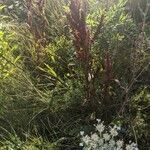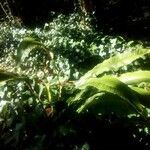Plants perennial, occasionally bi-ennial, glabrous or very indis-tinctly papillose normally only on veins of leaf blades abaxially, with fusiform, vertical rootstock. Stems erect, branched distal to middle, 40-100(-150) cm. Leaves: ocrea deciduous, rarely partially persistent at maturity; blade lanceolate to narrowly lanceolate or lanceolate-linear, normally 15-30(-35) × 2-6 cm, base cuneate, truncate, or weakly cordate, margins entire to subentire, strongly crisped and undulate, apex acute. Inflorescences terminal, occupying distal 2 of stem, dense or interrupted at base, narrowly to broadly paniculate, branches usually straight or arcuate. Pedicels articulated in proximal 3, filiform, (3-)4-8 mm, articulation distinctly swollen. Flowers 10-25 in whorls; inner tepals orbiculate-ovate or ovate-deltoid, 3.5-6 × 3-5 mm, base truncate or subcordate, margins entire or subentire to very weakly erose, flat, apex obtuse or subacute; tubercles normally 3, rarely 1 or 2, unequal, at least 1 distinctly larger, more than (1-)1.5 mm wide. Achenes usually reddish brown, 2-3 × 1.5-2 mm. 2n = 60.
Herbs perennial. Roots large. Stems erect, 50-120(-150) cm tall, simple or branched above, glabrous, grooved. Basal leaves shortly petiolate, lanceolate or narrowly lanceolate, 10-25 × 2-5 cm, glabrous or indistinctly papillose along veins below, base usually cuneate to truncate, margin strongly crisped and undulate, apex acute; cauline leaves shortly petiolate, narrowly lanceolate, small; ocrea fugacious, membranous. Inflorescence terminal, paniculate, narrow; branches erect or ascending. Flowers bisexual. Pedicel slender, articulate in proximal third, articulation distinctly swollen. Inner tepals enlarged in fruit; valves broadly ovate, 3.5-6 × 3-5 mm, all with tubercles, rarely only 1 valve bearing a tubercle, conspicuously net veined, base nearly truncate, margin entire, rarely weakly erose, apex obtuse to subacute; tubercle ovate, 1.5-2 mm. Achenes dark brown, shiny, ovoid, trigonous, ca. 2 mm, apex acute. Fl. May-Jun, fr. Jun-Jul. 2n = 60.
Mostly unbranched coarse glabrous perennials with yellowish taproots. Leaves glabrous, lanceolate to oblong, apically acute, basally acute to cordate, the cauline blades mostly 10-12 cm. long by 0.5-3 cm. broad; petioles 1-5 cm. long; ochreae up to 2.5 cm. long, tardily deciduous. Inflorescences of crowded many-flowered ochreolate verticils in racemes or panicles. Flowers perfect, on pedicels mostly 5-12 mm. long; outer tepals oblong, 1-2 mm. long, scarcely accrescent; inner tepals broadly ovate to cordate, accrescent becoming 3.5-5 mm. long, 2-3.5 mm. broad, with a prominent exterior tubercule developing on 1 or 3 of them; stamens 6, discrete, the filaments mostly less than 0.5 mm. long, the anthers 1-1.5 mm. long, basifixed; ovary trigonous, the 3 styles usually reflexed, with 3 peltate fimbrillate stigmata. Achenes triquetrous, brown, lustrous, included, often capped by the persistent styles and stigmata, 2.5-3 mm. long, 2-2.5 mm. broad.
A stout, ± glabrous perennial.. Stems brownish-red to greenish-brown.. Leaves sometimes tending to redden, glabrous except for papillae on the veins of the subsurface, narrowly oblong-lanceolate, 15–26 × 2–5.5 cm. (–35 × 8 fide Rech. f.), the upper ones often linear; crisped on the margins; apically ± acute, basally attenuate, cuneate, or rounded, often rather unequally so. Lower petioles up to 20 cm. long; those of the stem leaves much shorter, often 1.5–3 cm.. Inflorescence a rather dense, branched panicle.. Inner tepals 3.5–5 mm. long, and as broad or nearly so, ovate-deltoid, usually all tubercled, the margins entire, undulating, or very slightly and shallowly toothed towards the base.. Nut 2.5–3 × 1.5–2 mm., medium brown, acutely trigonous.
Stout, taprooted perennial to 1.5 m, simple to the infl; lvs strongly crisped, the larger commonly rounded to subcordate at the base; infl large, with many ascending or erect branches, becoming compact at maturity, with some linear lvs intermingled; pedicels flexuous, 5–10 mm, spreading-decurved, jointed near the base; valves thin, broadly ovate, 4–5 mm long and wide, entire or nearly so, obtuse, truncate or subcordate at base; grains 3, often unequal, the larger broadly ovoid, very turgid, rounded at both ends, half as long as the valve; 2n=60. Native of Europe, found as a weed of roadsides, fields, and waste ground throughout the U.S. and s. Can. (R. elongatus) Hybridizes with nos. 9 [Rumex patientia L.] and 16 [Rumex obtusifolius L.].
Perennial herb, 0.2-2.4 m high; erect. Leaves: petioles shorter than lamina; lamina of basal leaves up to 300 x 60 mm, margins wavy, attenuate at both ends; upper cauline leaves smaller. Inflorescences erect, branches slightly patent, ± compact in fruit. Flowers in many-flowered whorls. Flowering time Aug.-Mar. Fruiting pedicels longer than valves. Fruiting valves orbicular-cordate, green, drying brown; callosity relatively small, basal on main vein of each valve, ovoid, apex long attenuate. Fruit a dark brown nut, up to 3.5 mm long.
An erect herb. It can grow up to 1 m tall. It keeps growing from year to year. The leaves are smooth. They are sword shaped or oblong and up to 30 cm long. They are wavy along the edges. The leaves at the base are larger with larger leaf stalks. The flowers are very small. They are greenish. They are crowded in rings on a branched flower stalk. The flowering stems can be 1.2 m high. The fruit is dry and one seeded. It is 3 angled. The seed valves are broad and 4-6 mm long. They do not have spines.
Lower leaves up to (3.5)6–26 × 5–14 cm, lanceolate or oblong-lanceolate, narrowed and attenuate to the base, sometimes ± cordate, undulate and crisped on the margins, glabrous or with papillae on the veins beneath; upper leaves often linear, acute at the apex, cuneate or rounded at the base often asymmetrically so; petiole up to 20 cm long, as long as or shorter than lamina, 1–3 cm long in stem leaves.
Perennial herb, up to 1.5 m high. Stems erect, stout, striate. Leaves petiolate; blade of lower leaves narrowly ovate, 60-260 x 50-140 mm, decurrent, upper leaves linear, apex acute, margins crisped, undulate. Ocrea brown, membranous, usually caducous. Flowers: perianth with inner segment entire, callosity small, covering a small part of inner perianth segments, white or pale green; Oct.-Mar.
Outer perianth segments 1.5–2.5 mm long; inner perianth segments 3.5–6 × 3–5(6) mm, broadly ovate-triangular to ovate-cordate, strongly reticulate, usually one segment with a developed dorsal tubercle near the base, the others with or without small tubercles; margins entire, wavy or very slightly toothed towards the base.
Flowers hermaphrodite or unisexual, pedicellate, in congested many-flowered whorls, arranged in rather dense branched panicles; pedicels filiform, up to 0.3 mm in diameter, unequal, up to 1 cm or more long in fruit, articulated below the middle.
Perennial herb, up to 1.5 m high. Leaves large, strap-shaped, crisped along margins. Inner perianth segment entire. Callosity small. Flowers white or pale green.
Stems brownish-red to greenish-brown, longitudinally striate, glabrous.
Stamens 6; filaments 2.5 mm long; anthers 0.2–0.3 mm long, oblong.
Nut brown, shiny, 2.5–3 × 1.5–2 mm, sharply trigonous.
An erect stout perennial herb up to 2(2.5) m tall.
Ocrea 1–2 cm long, striate, entire.
Ovary 1.5–2 × 0.7–1 mm, trigonous.












